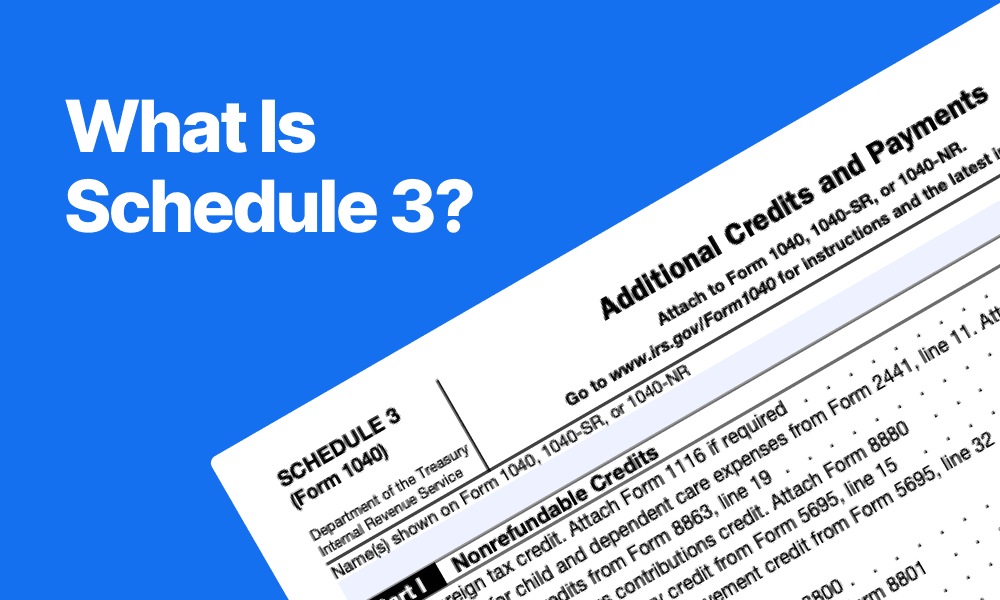What Is IRS Schedule 3 (Form 1040)? Claim Additional Tax Credits & Payments | TAXtical

Schedule 3 (Form 1040): What It Is, Who Needs It, and Why It Matters
When filing your IRS Form 1040, certain tax credits and additional payments may not fit directly on the main form. That’s where Schedule 3 comes in. It allows taxpayers to claim nonrefundable credits and report other payments that can reduce their overall tax liability.
In this blog post, TAXtical explains everything you need to know about Schedule 3, including:
What Schedule 3 is
Who should file it
What’s included in Schedule 3
How to file it
How TAXtical can help simplify your filing process
What Is Schedule 3 (Form 1040)?
Schedule 3, titled “Additional Credits and Payments,” is a supplemental form used with IRS Form 1040 or 1040-SR. It allows you to:
Claim additional tax credits (such as education credits or foreign tax credits)
Report other payments (like excess Social Security tax withheld or tax payments made with an extension)
The credits on Schedule 3 are typically nonrefundable, meaning they can reduce your tax to zero but won't result in a refund beyond what you paid in.
Who Should File Schedule 3?
You should file Schedule 3 if you qualify for any of the following:
✅ Education credits (like the Lifetime Learning Credit)
✅ Credit for child and dependent care expenses
✅ Foreign tax credit
✅ Residential energy credits
✅ Retirement savings contributions credit
✅ Excess Social Security or RRTA tax withheld
✅ Net premium tax credit
✅ Repayment of the first-time homebuyer credit
✅ Payment with extension requests (Form 4868)
✅ Other specified tax payments
Schedule 3 is commonly filed by:
Families with dependents or education expenses
Homeowners making energy-efficient upgrades
Self-employed individuals who made estimated tax payments
Taxpayers who worked in multiple jobs or abroad
Why Is Schedule 3 Important?
✅ Maximize Tax Savings – Claim every available tax credit to reduce your bill
✅ Report All Payments – Ensure all estimated taxes or payments with extensions are credited
✅ Avoid IRS Notices – Filing Schedule 3 correctly avoids underpayment errors
✅ Improve Accuracy – Schedule 3 breaks out details that don’t belong directly on Form 1040
Credits and payments reported on Schedule 3 are summarized in lines 20 and 31 of the 1040 form and directly affect the final tax owed or refund amount.
How to File Schedule 3
Schedule 3 is typically completed and attached to your Form 1040 or 1040-SR. The form has two parts:
Part I – Nonrefundable Credits
Includes:
Foreign tax credit
Education credits
Child and dependent care credit
Retirement savings contribution credit
Residential energy credit
Part II – Other Payments and Refundable Credits
Includes:
Estimated tax payments
Excess Social Security tax withheld
Payments made with extensions
Refundable premium tax credit
You can file it electronically or by mail with your tax return. Tax software usually includes it automatically if you qualify.
Common Mistakes to Avoid
❌ Forgetting to attach Schedule 3 when claiming credits
❌ Failing to report estimated tax payments or extension payments
❌ Claiming a credit you're not eligible for (like education credits without proper documentation)
❌ Missing out on credits like the Saver’s Credit for retirement contributions
Let TAXtical Help You Maximize Your Credits
Filing taxes isn’t just about avoiding penalties — it’s about getting every dollar you’re entitled to. TAXtical’s team of experts ensures you:
🔹 Claim all eligible credits and deductions
🔹 Properly report tax payments
🔹 Avoid costly filing mistakes
🔹 Stay fully compliant with IRS regulations
🔹 Receive the best possible refund (or reduce your tax due)
Get Help With Schedule 3 and More
Whether you’re a parent, homeowner, student, or self-employed, Schedule 3 could help lower your tax bill. Let the professionals at TAXtical guide you through the process with confidence and ease.
📞 Contact TAXtical today for a free consultation and get expert support in maximizing your tax credits.

